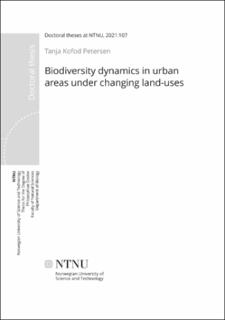| dc.contributor.advisor | Austrheim, Gunnar | |
| dc.contributor.advisor | Speed, James D. M. | |
| dc.contributor.advisor | Grøtan, Vidar | |
| dc.contributor.author | Petersen, Tanja Kofod | |
| dc.date.accessioned | 2021-03-29T07:20:29Z | |
| dc.date.available | 2021-03-29T07:20:29Z | |
| dc.date.issued | 2021 | |
| dc.identifier.isbn | 978-82-326-5431-4 | |
| dc.identifier.issn | 2703-8084 | |
| dc.identifier.uri | https://hdl.handle.net/11250/2735829 | |
| dc.description.abstract | Ecology goes to town
Urbanisation is increasing worldwide, but as urban expansion inevitably happens at the cost of other ecosystems, understanding how this will affect biodiversity is crucial. Especially if we wish to conserve native, threatened species, and minimise the negative impacts from introduction of alien ones. One of the main obstacles to ecological research is data scarcity. However, the amount and availability of species occurrence records have increased immensely in recent years – particularly due to the increased number of “citizen science” records registered in online data portals, such as the Global Biodiversity Information Facility (GBIF). Unfortunately, such records comes with a range of biases.
In my thesis, I aim to assess the availability and utility of GBIF data on species occurrences and distributions in Norway and Trondheim, examine the effects of urbanisation on biodiversity, and provide suggestions on how to develop cities and manage biodiversity within them in a more sustainable fashion.
The results show how biodiversity data from Norway and Trondheim are greatly skewed regarding species- and conservation groups, and their geographic distributions. Land-cover and land-cover related variables determine number- and distribution of species in an urban-rural context: threatened species are generally found in habitats with low human pressure, whereas alien species richness is mainly determined by the initial introduction site. Disturbance-tolerant plant species adapted for rapid resource acquisition are found in urban areas, compared to stress-tolerant species outside of the city. As land-cover changes, bird communities will become less diverse – in particular, we will lose forest- and wetland specialist, and be left with generalists. To favour native biodiversity in future urban development, these studies recommend to minimise the conversion of vulnerable habitats as much as possible and to monitor urban areas closely to mitigate the introduction and spread of alien species. | en_US |
| dc.language.iso | eng | en_US |
| dc.publisher | NTNU | en_US |
| dc.relation.ispartofseries | Doctoral theses at NTNU;2021:107 | |
| dc.relation.haspart | Paper 1: Petersen, Tanja Kofod; Speed, James David Mervyn; Grøtan, Vidar; Austrheim, Gunnar. Species data for understanding biodiversity dynamics: The what, where and when of species occurrence data collection. Ecological Solutions and Evidence 2021 ;Volum 2.(1) | en_US |
| dc.relation.haspart | Paper 2: Petersen, Tanja Kofod; Speed, James David Mervyn; Grøtan, Vidar; Austrheim, Gunnar. Urban aliens and threatened near-naturals: Land-cover affects the species richness of alien- and threatened species in an urban-rural setting. Scientific Reports 2020 ;Volum 10. s. - | en_US |
| dc.relation.haspart | Paper 3: Petersen, T.K., Speed, J. D. M., Grøtan, V., Austrheim, G. Competitors and ruderals go to town: Plant community composition and function along an urbanization gradient Nordic Journal of Botany This article is awaiting publication and is therefore not included | en_US |
| dc.relation.haspart | Paper 4: Petersen, T.K., Speed, J. D. M., Grøtan, V., Frøyen, Y.K., Austrheim, G. (submitted). Urbanisation and land-cover change affect the functional turnover of bird communities but not the extent of species composition change. Submitted manuscript to Journal of Urban Ecology. This article is awaiting publication and is therefore not included | en_US |
| dc.title | Biodiversity dynamics in urban areas under changing land-uses | en_US |
| dc.type | Doctoral thesis | en_US |
| dc.subject.nsi | VDP::Matematikk og Naturvitenskap: 400::Basale biofag: 470 | en_US |

